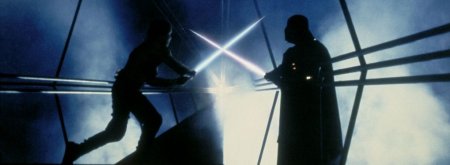'Feeling The Force' - Star Wars and Spiritual Truth
A long time ago in a galaxy far, far away, there was no God. Or not, at least, the walking, talking God of the Old and New Testament Scriptures, who sorrows, warns, blesses, commands, promises, sees, hears and touches.
Instead of God, George Lucas’ Star Wars saga speaks of ‘The Force’. Taken from Arthur Lipsset’s 1963 short movie 21-87, the term nevertheless carries clear connections with more recognisable theology. For instance, the blessing ‘May the Force be with you’ echoes an old Christian one of ‘May God be with you’. In addition, the voice of the spectral Jedi Master Obi-Wan proclaims to young Luke Skywalker ‘Remember, the Force will be with you always’, reflecting Jesus’ comforting of his disciples: ‘And remember, I am with you always, to the end of the age’, (Matthew 28:20).
If not generally acknowledged as spiritual classics by most, the two trilogies have proven to be more enduring than many in their often ephemeral genre. If the Force is going to be with us for the foreseeable future, can we extract any spiritual sustenance from it?
Many Christians have found this celluloid deity unnerving. The Force is too eastern, they complain, and cannot therefore teach Christians anything theologically. Some even believe it to be a ‘mythology ... perfectly adapted to the spiritual confusion of post-modern America’ that constitutes an advert for post-Christian neo-paganism. [1]
Spiritual Re-Packaging
Lucas claims that the Force is not an alternative religious option, and certainly not the religious option, but is instead little more than a plot device to allow certain aspects of the fantasy to develop. It is a kind of mental and psychical energy-amplifier that enables the Force-conscious characters to perform certain super-human feats. (The science of the fantasy offers a parallel here – it would be an absurd category mistake to ask whether the movies’ technologies are scientifically feasible.) Even if it did have some theological significance, that would only be quite modest since Lucas hoped merely to encourage thinking about spiritual matters, and he certainly does not coercively evangelise on behalf of a new pop-religion. Far from introducing anything new, Star Wars’ creator aims to distil the essence of the old in new packaging.
In this regard, the saga is concerned with secularism’s dismissal of religion, as is suggested by the second time audiences hear of the Force in A New Hope.[2] In the Death Star briefing room Admiral Motti commends the Empire’s newfound ability to control the galaxy through the construction of what he calls ‘the ultimate power in the universe’. A menacing Darth Vader bitingly advises: ‘Don’t be too proud of this technological terror you have constructed. The ability to destroy a planet is insignificant next to the power of the Force.’ Obi-Wan has already revealed that Vader had turned to ‘the dark-side of the Force’, and the comparison of the Force and power is significant, especially when ‘power’ here refers to the might of the Death Star. Motti sneeringly dismisses Vader’s warning with a reference to ‘your sorcerer’s ways’ and ‘sad devotion to that ancient religion’ which has proven ineffective in locating either stolen data tapes or the Rebels’ hidden fortress. However, Vader’s reaction of choking Motti by the mere power of his thought indicates that Star Wars’ sympathies are not with this secularist.
A Common Essence
When pressed to say something about the Buddhist influence on Star Wars, Lucas discloses: ‘I guess it’s more specific in Buddhism, but it is a notion that’s been around before that.’[3] Star Wars, in fact, seems to resonate with something of a pluralist ethos, perhaps learned through mythology scholar Joseph Campbell’s ‘monomythic’ approach to the world’s religions: all share a common essence, an essence that may be identified without the guidance of any particular religious system.
Suggestively, the Force is portrayed in quasi-pantheistic terms as ‘an energy-field created by all living things’ that ‘surrounds us and penetrates us’ (Obi-Wan to Luke, ANH). By the time of The Phantom Menace (1999), the first of the ‘prequels’, this pantheistic imagery is conveyed in quasi-biomechanical terms – what many critics complain of as ‘bio-babble’ – in Jedi Master Qui-Gon Jinn’s teaching to the youngster Anakin Skywalker about the composition of The Force: ‘Midi-chlorians are a microscopic life-form that reside within all living cells ... inside your cells ... And we are symbionts with them.’
John Caputo suggests from this that ‘The basic religious schema of Star Wars is rather more Eastern than Judeo-Christian.’[4] And, of course, there are indeed numerous noticeable eastern images and themes pervading these movies – for instance the Jedi Knights are Samurai-like (‘jidaigeki’ are samurai period drama movies). However, the presence of numerous Christian images should not be obscured – Darth Vader and Darth Sidious’ temptations, for example, echo Satan’s temptations of Adam and Christ (Empire Strikes Back, Revenge of the Sith, respectively, and together in Return of the Jedi). Moreover, while it is true that the Buddhism of ESB’s director Irvin Kershner cannot be unimportant to Yoda’s characterisation, the Jedi Master is designed more as a representative of a wider universal wisdom, and the deliberate Einstein-like touch in his facial design testifies to that.
This, among other things, suggests that Lucas’ borrowing is more eclectic and post-modern than specifically eastern as such. The driving spirit appears to be a catch-all concept that imposes something of a hypothetical commonality onto all religions and thereby underplays their important differences. Consequently, while John Brosnan thinks that Lucas creates ‘a safe religion that doesn’t step on any theological toes’, the Force may well step instead on all of them.[5]
Thin Similarities
Yet precisely because pluralism attempts to find a common essence of religion we should expect the Force to have at least some, even if only thin, lines of similarity with Christian beliefs.
According to some commentators the Force can be manipulated precisely because (in ANH) it is portrayed by Obi-Wan to Luke as a magical ‘energy field’ that ‘gives the Jedi his power’. It is even used by Obi-Wan to manipulate an Imperial Sandtrooper’s conscious will. The moral concern with this is that because The Force is portrayed as that which is ultimate, if its nature is power then power is the ultimate truth and reality of all things.
In ESB the presentation of the Force has been immeasurably enriched and its relation to power is portrayed in a more morally demanding way of its bearers. For instance, the Force’s demand for non-aggression forces Luke to re-evaluate his perception not only of the nature of a Jedi but also of the character of the Force. Learning to be mindful of the living Force draws the Jedi devotees deeper into the ethical life and the truth that all things are interconnected and responsible, something that the Sith, for all their power in manipulating the Force, destructively fail to appreciate.
Obedience to ‘the will of the Force’ is not blind acquiescence to a powerful but morally ambiguous god, and certainly is not a giving absolute significance to one’s own desires. On the contrary, it is the journey into becoming self-dispossessingly responsible for the wellbeing of the galaxy, or, more personally, one’s galactic neighbour. This means that the virtues of co-responsibility, compassion and so on are ultimately the truth of life. The Force has to do with dependence and creative self-giving, not autonomy and possessiveness. Of course, the immensely rich Christian image of the triune God, the one who as Father, Son and Spirit inexhaustibly and endlessly lives in self-disposing relationships of self-giving, is not one Lucas uses in these movies. The very undifferentiated oneness of the Force can make its ethical demands potentially more ambiguous since it does not contain within its singular self the sense of difference-in-relation.[6]
Nevertheless, the Force, at least, is the object of Jedi contemplation in such a way that the Jedi learn to focus on that which is other than themselves. This is but one of several features of it that provides rich potential for resisting the self-seeking competitiveness that becomes so destructive of others (‘the dark-side’, the way of the Sith), indicating instead the virtue of life-affirming agency in, with, and for the flourishing of the shared life of all things. Consequently, the Force-conscious Jedi play the role of galactic guardians and (in theory at least) live in relations of healthy and non-exploitative interdependency. It is they who represent peace and justice in the Republic. So when President Ronald Reagan claimed in 1986 that ‘the Force is with us’ he was actually perverting Star Wars’ self-dispossessing (or other-focused) ethos.[7] ANH’s blessing ‘May the Force be with you’ is the expression of a hope for others, not a possessive assertion for ourselves. Reagan’s rhetoric here, like the way of the Sith, is out of kilter with the moral demands of the Force. It is an expression of the ‘dark side of the Force’ that is, Lucas explains, ‘like a huge cancer, alive, festering’ as a ‘symptom and symbol of a very sick society.’[8]
Star Wars, then, identifies evil with disordered desire, with the seeking of that which cannot and should not be desired, while the demands of ‘the Good’ are those that reorder our desire. Nonetheless, knowing and doing ‘the Good’ are not easy tasks. Anakin is portrayed as knowing the ways of the Force perhaps more intensely, or at least more powerfully, than any other Jedi living or dead. Yet not only does that fail to prevent him from turning to the dark-side and becoming the ill-fated distortion of a human being (Darth Vader), but the knowledge and Force/power he has are those qualities he draws upon to commit the most destructive deeds against the Jedi Order itself.
A Complex Web
In Star Wars the theme of responsibility for the life-affirming care of all things makes sense through the surrounding and binding presence of the Force in and to all things. All things are symbionts with the Force and therefore one another, interconnected in some way in a complex web, and consequently to exploit any aspect of that arrangement for one’s own gain is to significantly risk the delicate balance of life.
Described in this way, there appears to be more similarity between Lucas’ Force and certain Christian understandings of God’s presence than is admitted by those who are worried about its pantheistic quality. Obi-Wan’s teaching that the Force ‘surrounds us, it penetrates us, it binds the galaxy together’ (ANH) strikingly evokes Pauline imagery of ‘one God and Father of all, who is over all and through all and in all’ (Ephesians. 4:6). When Christians read the agency of God in terms of God’s presence in Jesus Christ (John 1:3; Colossians 1:16) the will of the Creator is understood to have saving significance for all things. This idea shapes our understanding not merely of the intrinsic value and dignity of human creatures but also of the non-human creation, thereby resulting in a theologically informed ethic that recognises and acts for the flourishing of the non-human creation. Abuse of human and non-human creation, then, disrupts the proper and fruitful associations of interdependent relations among God’s creatures. And, finally, we must recognise that the Holy Spirit is the ongoing presence of the cosmic and intimate Creator making all things new. ‘Clearly,’ argues Bryan Stone, ‘the Holy Spirit does bear some resemblance to the Force of Star Wars.’[9] Christians who unknowingly affirm dualistic cosmologies, and who construe salvation in terms of being saved from the world for another world, miss this.
Impersonal or Embodied?
But isn’t the Force impersonal, and therefore in conflict with the Christian understanding of God, as Stone also maintains? Certainly apart from Qui-Gon’s anthropomorphic talk of ‘the will of the Force’, it tends to be referred to in predominantly impersonal ways. Yet we must recognise that much of the Christian tradition itself remains attentive to the metaphorical nature of all God-talk. That means that when one speaks of God as personal, or as one God in three ‘persons’, one must resist making the Creator merely another creature. God, as the Creator of all that is, cannot be a member of any or every thing or of any class of being, but is rather the source and goal of all that is and thus is beyond the kind of personality human persons or animals have or the impersonality that stones and molecules have. In this way, C.S. Lewis claims, ‘Christians are the only people who offer any idea of what a being that is beyond personality could be like.’[10]
Certainly the very mechanics of the presence of the Force groan under the weight of being pressed too hard, particularly since it only performs a very broad role in the movies. Yet the notion of the co-existence and interdependence of all life-forms in the Force can offer a liberating alternative to the prevailing philosophies of the Western world that emphasise the importance of the individual, and her rights, freedoms and choices. Our being persons (our ‘personhood’) occurs not by being isolated from others as purely autonomous selves, but instead by being formed in multiple webs of relationships. The dependency of all things on the meaning-shaping Force, then, is a theme that resonates with something of the Christian doctrine that God’s creating makes healthy sets of morally responsible relations.
A Larger World
After the success of ESB, Lucas revealed that ‘This is the kind of movie we need. There needs to be a kind of film that expresses the mythological realities of life - the deeper psychological movements of the way we conduct our lives.’[11] But Star Wars was never intended to offer a ready-made religion, which is why the Force is a rather vague amalgamation of different things. ‘All I was trying to say in a very simple and straightforward way’, Lucas reveals, ‘is that there is a God and there is a good and bad side.’[12] Perhaps its popular reception reveals more about some search for moral absolutes, and of the migration of the spiritual quest from more traditional forms into something more diffuse, abstract and individualistic.
Yet the Star Wars saga does raise significant ethical questions – what are we to do with evil, and how do we identify it? – in such a way that even if it is ‘religion-lite’ there remain quite a number of important ethical strings attached. That was, of course, Lucas’ intention at least from 1975 onwards with his efforts to fill the vacuum of a lack of popular resources for youth culture’s moral reflection. In its own way, the most recent Star Wars trilogy in particular, and possibly even the earlier ESB, demonstrate the difficulty of moral intuition, and when they are at their most theologically interesting they encourage us to think hard about the most intimate and personal of topics – the idea of the human itself. Like any great myth the saga may give us, in the words of one reviewer, ‘glimpses “through a glass darkly” of things essential and true. Virtue, courage, patience, peace, self-control, love ... the Good Side are they.’[13]
John McDowell has written more extensively on Star Wars and spiritual truth in his book The Gospel According to ‘Star Wars’: Faith, Hope and the Force, published by Westminster / John Knox Press, May 2007. Buy it from Amazon.
References
[1] R. Albert Mohler, ‘Faith Vs. the Force’, World Magazine 21.1 (Dec 31, 2005).
[2] Individual films from the original trilogy and prequel may be referred to using acronyms: TPM (The Phantom Menace, 1999); AOTC (Attack of the Clones, 2002); ROTS (Revenge of the Sith, 2005); ANH (A New Hope, 1977); ESB (The Empire Strikes Back, 1980); ROTJ (Return of the Jedi, 1983).
[3] George Lucas, ‘Of Myth and Men: A Conversation Between Bill of the Force and the Moyers and George Lucas on the Meaning of the Force and the True Theology of Star Wars’, Time 153.16 (April 26, 1999). Lucas defined his religion as ‘Buddhist Methodist’ [in John Baxter, George Lucas: A Biography (London: Harper Collins, 1999), 165].
[4] John D. Caputo, On Religion (London and New York: Routledge, 2001), 83.
[5] John Brosnan, The Primal Screen: A History of Science Fiction Film (London: Orbit, 1991), 181.
[6] Christian history itself is littered with the unwitting worship of gods of self-protection, personal comfort, and self-aggrandising aggression against others – for example, against non-males, non-whites, non-Protestants, non-Christians, and all others who are not like ‘us’.
[7] In Robert Jewett and John Shelton Lawrence, Captain America and the Crusade Against Evil: The Dilemma of Zealous Nationalism (Grand Rapids, Mich.: Wm. B. Eerdmans, 2003), 26.
[8] On how the saga resists a cosmic dualism, see John C. McDowell, The Gospel According to ‘Star Wars’: Faith, Hope and the Force (Westminster, John Knox Press, 2007), ch. 3.
[9] Bryan P. Stone, Faith and the Film: Theological Themes at the Cinema (St Louis, Miss.: Chalice Press, 2000), 135.
[10] C.S. Lewis, Mere Christianity (Glasgow: Collins, 1952), 137.
[11] In Michelle Kinnucan, ‘What Star Wars Teaches Us’, Common Dreams.org (10 May 2002).
[12] In Chris Salewicz, George Lucas Close Up: The Making of His Movies (London: Orion, 1998), 47.
[13] Jeffrey Overstreet ‘Star Wars: Episode III – Revenge of the Sith’, Christianity Today (18 May 2005).
© 2007 John McDowell



